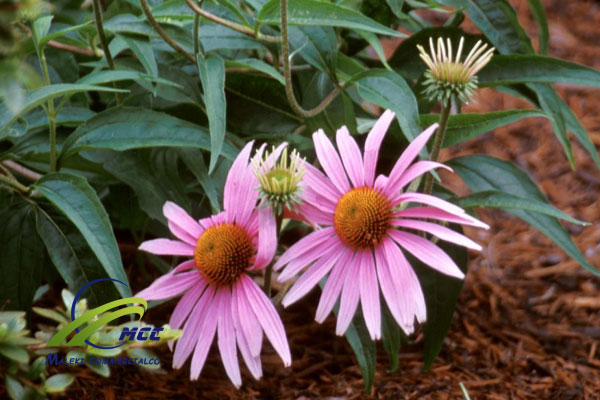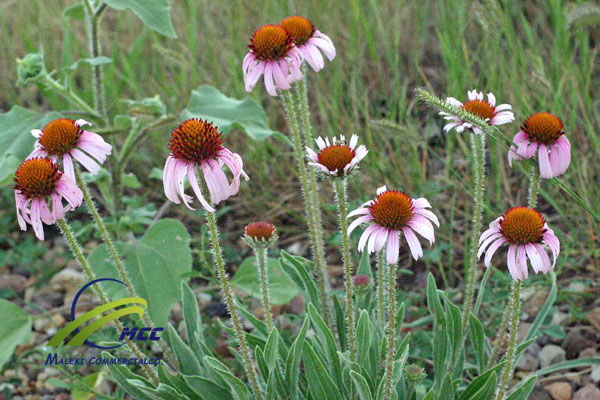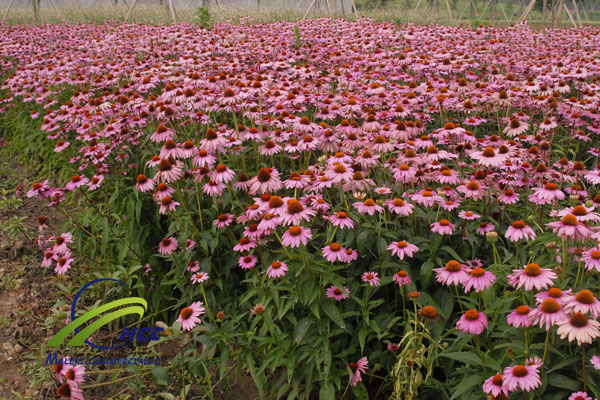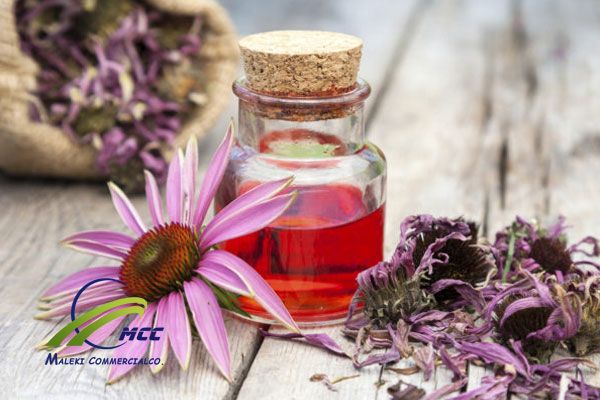Everything about Purple coneflower
What is purple coneflower?
Purple coneflower (Echinacea purpurea. L) Moneh belongs to the Asteraceae family which is one of the plants with amazing properties that are in high demand in the world trade market.
Botanical characteristics
purple coneflower is a perennial and herbaceous plant. It reaches a height of 50 to 150 cm. The stems are glabrous or with scattered hairs and can be found in light green color or even in red. The leaves are rough, often with a serrated edge, and the lower leaves are ovate with long petioles. Also, the leaf tip is pointed and usually narrows at one time along the length of the 5 veins, and the leaf base is heart-shaped. The flowers are conical and purple or bright red, very rarely whitish, and appear at the ends of the main and secondary stems.
The brown rhizomes are 30 cm high and 1 to 1.5 cm in diameter and contain black spots.
Chemical compounds
This plant contains polysaccharides, water-soluble glycoportins, flavonoids, alkamides, alkylamides, chicory acid, isobutylamide and essential oils.
Pharmaceutical part
- Aerial organs
- Rhizome
 Geographical distribution
Geographical distribution
Global distribution
This plant is cultivated in Iran, Europe and the Americas.
Distribution in Iran
This plant grows in Tehran, West Azerbaijan, Gilan and Mazandaran provinces.
Ecology of cultivation
- This plant grows in moist, light locations and humus-rich soils with a fertile texture, tolerating temperatures as low as 10°C throughout the winter.
- This perennial plant does not need to be cultivated for up to 4 years and has a high economic value.
- The function of the vegetative body and the amount of active ingredients decrease after the fourth year, deteriorating the medicinal properties.

Fertilizers needed for cultivation
1- Animal manures
- For autumn planting, 20 to 30 tons of rotted cow manure are needed per hectare.
2- Chemical fertilizers
- In spring before planting, 50 to 80 kg of phosphorus oxide, 70 to 50 kg of potassium oxide and 40 to 60 kg of nitrogen are required per hectare.
- Since this plant is perennial, it grows best if you apply 30 to 50 kg/ha of nitrogen to the soil each spring after weeding.
Preparation of the soil
After strengthening the cultivated field with animal fertilizers, the field should be plowed in autumn to a depth of 30 to 50 cm. Also, it is important to fortify the soil with animal manure and collect stones.
Cultivation methods
1- Indirect cultivation
- For indirect cultivation in nursery beds, the soil should be rich in humus and free from weeds.
- For this type of cultivation, the treasury bed should be rolled widely before planting.
- The best time for this type of cultivation is the first half of March.
- Approximately 2.5-3.5 kg of seed is required per hectare.
- First prepare a suitable seedbed for sowing; and then, sow the seeds in rows 20-25 cm apart in the open air.
- The depth of planting in a nursery bed should be 1 to 1.5 cm.
- Seedlings should be transplanted to the main field when they have four to five leaves, and cultivated at a distance of 30 cm apart and rows in 40 cm when they reach that stage.
- The seedlings should be transplanted to the main field between August 6 and September 6, which should be irrigated immediately after transplanting.
2- Cultivation by vegetative propagation
- This method uses plants that are 2 to 3 years old and free from fungal infection. Each plant is divided into 5 to 10 pieces which should be grown in the main field.
- Plants should be divided into pieces containing roots and at least one vegetative bud, and planted in the main field at a standard spacing.
- Weeding and regular irrigation will promote optimal plant growth.
Plant Harvest
- To harvest the vegetative body, this plant is harvested from a height of 15 to 20 cm above the ground in spring and after full flowering. To harvest 2 to 3 times a year, irrigate immediately after harvest and apply nitrogen fertilizer.
- To harvest the roots, you should harvest the vegetative body at the beginning of flowering in the spring of the second year of cultivation and then the roots in the autumn of the same year.
Medicinal-therapeutic properties of Purple coneflower
- Anti-toxin
- Anticancer
- Anti-inflammatory
- Antimicrobial
- Anti-Virus Virus
- Antiseptic
- Anti-inflation
- Pain killer
- Antibacterial
- Anticancer
- Antifungal
- Wound Healing
- Treatment of headache
- Treatment of measles
- Treatment of gonorrhea
- Treatment of burning sensation
- Treatment of itching
- Treatment of burns
- Treatment of bronchitis
- Treatment of sore throat
- Treatment of toothache
- Treatment of flu
- Treatment of chronic cough
- Treatment of infections
- Treatment of respiratory infections
- Treatment of sore throat
- Treatment of urinary tract infections
Consumption method
- Oral
- Local
Pour some of the roots or the aerial parts of the plant into half a liter of boiling water, and drink it after it is brewed.
Contraindications
- Pregnant women
- Patients with Multiple Sclerosis
- People with a history of autoimmunity or allergies
Precautions
- Elderly people over 60
- Children under 4
- Pregnant women
Side effects of overdose
- Nausea
- Vomiting
- Headache
- Dizziness
- Burning and itching
- Skin rash lower blood pressure
- Breathing problems
Note: consult your doctor before using this herb to treat the disease, please.
Maleki Commercial Company: largest exporter of purple coneflower
Maleki Commercial Company is the largest direct exporter of purple coneflower in Iran and Asia. Maleki Commercial Company exports the best quality of this plant according to the customer needs in the form of EXW, FCA, CPT, CIP, DAT, DAP, FOB, FAC, CFR, CIF.
You can contact our consultants for bulk purchasing.
purple coneflower supplier in Iran
Maleki Commercial Company exports the best quality of purple coneflower according to the customer needs in the form of EXW, FCA, CPT, CIP, DAT, DAP, FOB, FAC, CFR, CIF.
Global export of purple coneflower
Maleki Commercial Company is the global exporter of purple coneflower with the highest active ingredients and the best quality and price among all companies exporting this plant. This holding company has achieved great success in exporting this plant species to various countries without intermediaries.
If you need this high-quality export species, you can confidently get the best quality from Maleki Commercial Company with safe and standard packaging.
purple coneflower price in Iran
Maleki Commercial Company exports the best quality of purple coneflower under the Elisso Sky brand to Europe, Asia, and the United States, and has gained many customers’ satisfaction.

